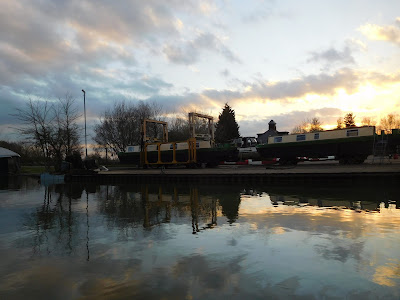We have a couple of days’ breathing space before we must be
on our way home. So we stayed put for the day and Dave took advantage of the
conveniently close bus stop to get to Leamington
station and travel back to Droitwich Spa marina for the car. So I did the really hard stuff of taking Meg
for a walk along the disused railway line in the glorious sunshine! Bridge 26A used to carry the old branch line
from Weedon to Leamington, passing through
Braunston, Flecknoe, Napton & Stockton, and Southam & Long Itchington
stations. The map here shows
how very useful it would be to boaters if it were still operating.
National Cycle route 41, known as the Lias Line, follows this
part of the old route. If you turn left
from the bridge you will see that the path narrows and is in a direct line
towards Southam cement works, which was also served by the railway. The name ‘Lias’ refers to the geological
strata in this area, which also gives its name to the
Blue Lias pub further along the canal.
Comma butterfly
The section we walked along is managed by the Warwickshire
Wildlife Trust which is hoping to re-create the limestone grassland which would
have been here originally. At the moment there are banks of nettles which are
the food plant for the caterpillars of the brilliantly coloured Red Admiral,
Peacock, Small Tortoiseshell and Comma butterflies (so we shouldn’t complain
too much about nettles!). This comma had
been scrapping with another – like several other species, the males hold
territories and will see off interlopers as they wait for a female to come
along.
Dave returned mid-afternoon, having walked back along the
canal from Calcutt.
Before we left our mooring on Tuesday, we followed the old
railway line and the lane into Long Itchington village for some supplies – the
Co-op here has a much wider range than the little shop near the second lock.
We ascended Stockton
locks quite easily – there were several boats on their way down and in the end
we saw more boats in three hours than on any other day of this trip. One of them was the widebeam hotel boat Kailani which
looked rather more luxurious than Chuffed! It is based at Wigram’s Turn marina and was
off to the Saltisford Arm to collect passengers for its first trip of the
season.
The Willow Wren training base is having more construction
work carried out.
A little further on a pair of swans had chosen an elevated
site where reeds have been cleared, taking full advantage of the floating bits
nearby.
We moored for lunch on the stretch between the entrance to
Ventnor and Calcutt marinas, before Dave walked up to the office to find out
where we would be mooring. The sunshine
has brought the coltsfoot into full open bloom.
We are moored on the Calcutt visitor area. In the past we have been on one of the
permanent pontoons but there are so many more boats around now that they are
all full. This will make our preferred
cruising pattern of marina-hopping without a fixed plan more difficult than it
has been up to now. The outlook is not
so pretty now, but a working boatyard is better than a derelict factory.
10 locks, 3½ miles in 2 days
We packed up and went home on the Wednesday. The boat needs to come out of the water for
the rudder to be fixed, and we will have the hull blacked too. Dave discovered a leak from the gearbox the
other day so that needs to be fixed, but he will fit a new battery condition
meter himself. We are still waiting to
hear from RCR about the thermostat housing.
It’s not been quite the trip we hoped for! But nobody got hurt, the boat didn’t sink and
although there is money to be shelled out we were pleased to be out on the
water again and enjoyed our trip in spite of the frustrating bits.
Trip stats
We travelled 43
miles, 1½ furlongs of narrow canals and 20 miles, 5¼ furlongs of broad canals, about
64 miles in total. We travelled on the Worcester and Birmingham,
BCN Main Line and Icknield Port loop, North Stratford
and the Grand Union canals.
There were 108 locks – 65 narrow and 43 broad. On the North Stratford
there were 2 manually operated draw bridges and the electric Shirley
Drawbridge. We passed through 7 tunnels;
Tardebigge, Shortwood, Wast Hills, Edgbaston (twice), all on the W&B,
Brandwood on the North Stratford and Shrewley on the Grand Union.























